|
When the Spanish encountered the Trans-Pecos Mountains and Basins in the 16th century most of the native peoples of the region were foragers (hunter-gatherers)—peoples who lived off the land and moved from favored place to place as the seasons and weather dictated. Among the foraging peoples were the Chisos, Mansos, Jumanos, Conchos, Cibolos, Tobosos, Sumas, Cholomes, Caguates, Nonojes, Cocoyames, and Acoclames, to name only a few. Precious little is known about most—they were highly nomadic, lived in small bands, and generally avoided the Spanish. Most resisted Spanish efforts to "pacify" and congregate native peoples, and they suffered the ravages of slavery, disease, and rapid cultural upheaval. Some survived for a while longer by either becoming raiders and actively opposing the Spanish or by relocating to the most remote stretches of the Mountains and Basins. The end result was the same. None of the foraging groups survived the 18th century as a distinct people. But the archeological record shows that foraging was the dominant lifeway throughout prehistoric times, even after peoples in the La Junta area and in the western Trans-Pecos began settling down and raising crops.
The best known foraging peoples of the Trans-Pecos are the Jumano, as summarized in previous sections of this exhibit. Here we look at two additional groups, the Chisos and Mansos, who became known to the Spanish because their homelands were not far from La Junta de los Rios and El Paso del Norte, respectively. The Chiso (Chizo) Indians were a rather large nation of foraging peoples who lived in northern Coahuila and northeastern Chihuahua when the Spanish first arrived and also ranged into the southern Big Bend in somewhat later times. The Mansos lived along the Rio Grande in the El Paso area. The Chisos and Mansos are examples of the many named groups of foraging peoples in the Trans-Pecos region that are mentioned in Spanish documents beginning in the late 16th century.
Chisos
Spanish documents of the 17th century indicate that the Chisos lived just east of the Presidio Bolson, and south of the Rio Grande, a land that bordered the territory of the Tobosos. In the 1650s, they were generally found in the region of Parral (southern Chihuahua), but this appears to have been a temporary residence caused by raids of their rancherias by the Tobosos. In the rebellion of 1684, the Chisos played a prominent role, and at that time many of this nation were residents of La Junta de los Rios. Although the majority of the nations at La Junta de los Rios accepted peace and priests were assigned to them, the Chisos appear to have not been so inclined. Governor Pardiñas lamented the continued hostilities of the Chisos in 1688, stating that they had been hostile "for years," and sent soldiers after them. In 1714-1715 Trasviña stated that one of the perils of travel to/from La Junta was having to pass through the land of several rebel nations, one of which was the Chisos who lived east of the Conchos River.
The Chisos appear to have been a relatively large nation, subdivided into bands that sometimes acted independently and sometimes acted in consort with the other bands. Thus, some Chisos bands began to be named as independent nations in the early 17th century, but by the 1680s they were acting together against the Spanish. At that time the Spanish estimated that there were more than 400 Chisos among the more than 1900 allied Indians who were actively fighting against them. By 1687, the Chisos were at peace, and a sizable number were working in the Valle de San Bartolome .
Known Chisos bands were the Chichitames, Osatayoliclas, Cacalote, Cacuytattomes, Batayolicla, Ostayolic, Osatabay, Quescepayoligla, Cacuitatome; probable Chisos bands include the Simimbles, Coxocome and Tunmamar. Some documents only cite the name Chisos, especially in the early 17th century; other documents cite the name Chisos together with one or more of the bands names.
The Chisos were foragers who subsisted on small game, mescal, snakes, and bison and carried dried meat with them. The bison they obtained in winter hunts north of the Rio Grande. They also ate horses. Chisos captured in 1748 said they were selective about the horses they stole: they only wanted fat horses; the thin ones were left behind. One woman told of eating roots, and pinole (ground meal made of corn, wheat or mesquite). Tunas (prickly pear fruits) were also an important part of their food resources, and they are known to have temporarily suspended hostilities with the Spanish in the fall of 1684 to gather tunas. Sometimes the Chisos or their bands are cited subsisting on corn and other agricultural products, but it is relatively rare, suggesting that those items were obtained through exchange. When Governor Pardinas ordered General Retana into the field after the rebellious Chisos in 1688, he was adamant that they needed to be pursued until they agreed to live in pueblos.
The language of the Chisos is not well documented. It was apparently distinct from the Concho language since not all Conchos could speak with Chisos. Yet, one document clearly indicates that many Conchos were bilingual in that language. William Griffen has suggested that the Chisos and Conchos both spoke a language that was in the Uto-Aztecan language family (a broad group of languages spoken from Canada to Mexico).
The Chisos frequently were cited interacting with nations in northern Nueva Vizcaya or in La Junta de los Rios, and in 1684 were cited as residents of La Junta. Thus, the Julimes, Mamites, Conchos, Cibolos, and others were allies of the Chisos bands. In 1689, a few Chisos helped some Cholomes to recapture one of their women, and the year before Chisos had been aligned with Cholomes, Tobosos, Cabezas, Salineros, and Chichitames in a rebellion. In 1704-1705, they were helping the Sisimbles carry out raids in Coahuila. On a less regular basis the various bands of the Chisos interacted in friendship with the Salineros, Acoclames, Cocoyames, and Tobosos. They had also assisted these nations in the rebellions of the 1640s as well as those of the 1680s. The latter nations, however, also had a history of negative relations with the Chisos. Alonso, a Chiso chief, stated that he and his people had traveled to Parral, away from their land because of their wars with the Tobosos. In 1704 and 1716, the Chisos and Cocoyames joined together against the Acoclames.
When Trasviña y Retis prepared to travel to La Junta in 1715, it was stated that the Sisimbles, Chisos, Chinarras, Cocoyomes, and Acoclames were enemies of these nations at La Junta. This hostility must have been short-lived because some of the nations of La Junta joined the Sumas in the rebellion of the 1720s, and at that time the principal leader at La Junta was Don Alonso, a Chiso. Later, in 1747, Fermin de Vidaurre traveled to La Junta from Mapimi in the company of 50 Chisos, they were referred to as “Indios amigos,” suggesting that they had accepted peace.
Eventually, the Chisos suffered the same fate as so many others—fewer and fewer numbers because of conflict with Spanish, diseases, and absorption into the Spanish Colonial world as slaves and farm hands. The Chisos did not quietly accept their fate, however. They actively sought to hold their own against the newcomers. In the 1650s the Chisos began to play a prominent role in the hostilities around Parral and other Spanish settlements to the south of them. They became successful raiders and were involved in many conflicts with the Spanish as well as other native bands. Living well north of Spanish settlements and silver mines no doubt helped the Chisos survive a bit longer than many groups. Nonetheless, there is evidence that even this distance could not completely isolate them from the events happening to the south and it is likely that the Spanish raided their camps for slaves to work in the mines or on haciendas. Some Chisos bands and individuals opted for peaceful relations with the Spanish. At times, the Chisos themselves went south to seek work, usually during times of drought and famine, times that required tough decisions and harsh measures. By the early 18th century they were also in conflict with the Apache although some apparently joined with the Apache. By the mid-18th century, the Spanish authorities had settled most of the remaining Chisos in La Junta, among people that the Spanish knew had long been their allies. Once there, among their friends, they began to be called in Spanish documents part of the “people of La Junta,” some even acting as leaders of all the villages. Through time, however, their many varied and individual band names were dropped. By 1765, they, like the others who lived along the river in the Presidio Bolson, were referred to as simply “Indians.” The Chisos’ past had come to a close.
Mansos
The Manso were the native peoples who lived in the general area of modern El Paso where they were first encountered in 1581 by a small Spanish expedition chronicled by Hernan Gallegos. A year later, the Espejo expedition, as chronicled by Pedro de Lujan called the people of the El Paso area the Tanpachoas and said they lived near “lagoons” along the Rio Grande (then called the Rio Guadelquivir). In 1599 Don Juan de Onate, on his journey to establish a Spanish colony near modern Albuquerque, also encountered native people in the El Paso area. He forded the Rio Grande near Socorro, Texas, and found people he called “manxo, manxo, micos, micas, meaning tame [peaceful] and friends.” Although it is believed that the Mansos, the Tanpachoas, and the unnamed people encountered in the vicinity of modern El Paso are all the same native people, what is not clear from the Spanish manuscript is if this is the name the Spanish gave them because they were peaceful or if this is the Spanish translation of their own name for themselves. We will never know for certain. Regardless, from that time forward, the Mansos are mentioned in dozens of manuscripts ranging from birth, marriage, and death certificates, accounts of travel, court proceedings, and documents related to native uprisings.
The early descriptions of the Mansos reflect a remarkable friendliness. In 1581, Gallegos says the Mansos were quick to offer presents to the Spaniards, including “two bonnets made of numerous macaw feathers.” Since macaws are not native to any part of the Chihuahuan desert, the feathers and perhaps the bonnets themselves had come from hundreds of miles away either through trade or through long distance travel of the Mansos. When the Espejo expedition met the Mansos in 1582, the Mansos generously offered the visitors mesquite and fish. And, when Onate and his very large expedition—one that included soldiers, priests, and many families with their servants, cattle, sheep, and goods to establish northern ranches—try to ford the river in flood conditions, 40 Mansos helped them. The crossing is in the vicinity of modern Socorro, Texas. Because this was an expedition of colonization and not one of exploration, that crossing is celebrated in the region today as the first arrival of colonists, one that took place almost four decades before the famous Plymouth Landing in 1620.
Lujan’s diary says that the Mansos had nets to catch fish in the lagoons on the Rio Grande, and added that they also ate corn and the wildfowl (described as ducks, cranes, and geese) in and around the lagoons. Espejo tells us they lived in houses made of straw, and several early travelers say the Mansos wore their hair cropped short around their heads like a cap (gorreta in Spanish). In some accounts they are said to have plastered their heads red.
Although the 1582 journal says they ate corn, most documents indicate that the Mansos were hunters and gatherers. In his Memorial published in 1630, Benevides—a priest with considerable experience in New Mexico describes the Mansos as Gorretas who "do not have houses, but rather pole structures, nor do they sow; they do not dress in anything particular, but all are nude and only the women cover themselves from the waist down with deerskins." He also noted that, among other food items, they ate rats and fish. The Spanish often gave the Mansos food, he said, but the Mansos were also willing to share “all that they had” with the Spanish. Because the Mansos asked Benevides for a priest, “entering into a Rancheria of this nation Mansa, I put [erected] a Cross the height of a lance, and I told them, among other things, that this was the sign of God.”
A Spanish settlement began in El Paso in the early 1600s, and by 1659 a mission for the Mansos had been established there. Yet, according to a report by Captain Andres Hurtado in 1661, the nomadic lifestyle of the Mansos persisted. In 1663 documents from a trial, the Mansos are described in a derogatory way that seems to reflect an assumption that people who live differently from the Spanish were inferior: "The nation of Manso Indians is so barbarous and uncultivated that all its members go naked, and, although the country is very cold, they have no houses in which to dwell, but live under the trees, not even knowing how to till the land for their food".
With their world changing, a new people and a new religion being thrust upon them, the Mansos tried to find a balance and a future. On the one hand, they had given gifts freely, sharing what they had, perhaps in the true spirit of generosity but perhaps also to initiate a friendship with these odd newcomers with their horses, large and fierce dogs, and firearms. The documents provide evidence that their strategy did and did not work. The Spanish, at least at times, did give them food including the occasional cow to eat and the Mansos were not continually in revolt. Moreover, a mission was established for them and many were said to be baptized by 1682. On the other hand, as early as 1630, Benevides notes that the Mansos were well aware of the care they should take around the large fierce dogs the Spanish had with them because the dogs had bitten some aggressive Mansos. With the arrival in El Paso of several thousand people fleeing the Pueblo Revolt in August, 1680, life must have become quite difficult for all, including the Mansos. By 1682, Governor Domingo Gironza Petris de Cruzante wrote the Viceroy in Mexico about the dismal state of affairs in El Paso. Among other things, he notes that the Manso are Christian, but they too have revolted and with the Sumas they had attacked Janos.
Over the next several years, governors and soldiers wrote to superiors about Mansos who had revolted and were harassing posts at Janos and Casas Grandes, although other Mansos remained close to their mission in El Paso. Given the presence of the Piro and Tigua newcomers in the new settlements of Socorro and Ysleta, it is likely that the Mansos sought even more ways to secure their future. Certainly one way was to accept Christianity and seek comfort and protection by aiding at the mission. But other means seem to have been used too. In 1684, an Apache from New Mexico was captured. He had been captured by the Spanish when he was a boy and had married a Manso. Another Manso had married a Piro. In other words, the Mansos were forming bonds with outside groups as one means to secure the future. As another means, they took up arms against the Spanish and fled to the southwest, attacking Janos, Casas Grandes, and outlying ranches. Determined to stop yet one more revolt, a Spanish captain finds the Indians (Mansos with some Piros and Tiguas, and with Sumas and Janos) entrenched on a hill near Casas Grandes. He attacked at dawn and, although the Spanish eventually prevailed, the battle lasted all day. Forty people died and 27 were wounded, including the captain. The uneasy situation lasted several years with some Mansos trying to maintain their peace at the mission while others, fed up with Spanish domination tried to battle for their freedom.
Over time, and with the return of the Spanish to New Mexico, the Mansos appear to have been reduced to a small number living near their mission and/or intermarried with the Tigua and Piro. During his tour of northern lands in 1765, Bishop Pedro Tamaron y Romeral describes El Paso and the residents associated with it as comprised of 2,469 Spaniards and 249 Indians. Note that no tribal affiliation is provided. While it is likely that at least some were descended from the Mansos, it is hard to say how many. Interestingly, however, a group of people in Las Cruces, New Mexico who call themselves the Piro-Manso-Tiwa Indian Tribe are seeking federal recognition as a tribe from the Bureau of Indian Affairs.
|
|
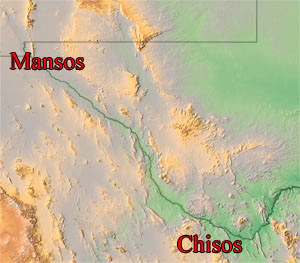
The Chisos Indians lived primarily in northern Coahuila and northeastern Chihuahua during the 17th and 18th centuries. The Mansos lived along the Rio Grande in the El Paso area. These were two of many different foraging peoples occupying the Trans-Pecos Mountains and Basins at the outset of written history. |
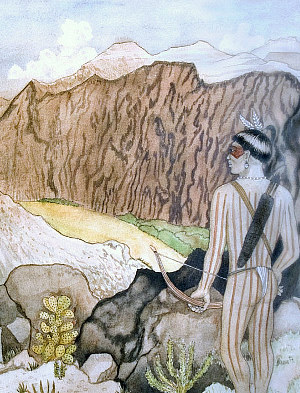
Artist’s depiction of a hunter on an overlook high above the Rio Grande. In the 17th century the Chisos bands seemed to have lived mainly south of the river and mainly east of the Rio Conchos. But they ranged widely and were sometimes seen along and across the river. Some modern sources claim that the Chisos primarily lived in the Big Bend area in the vicinity of their namesake Chisos Mountains. However, Spanish documents of the 17th and 18th centuries consistently place most Chisos bands south of the Rio Grande. This 1994 painting by artist Feather Radha can be seen in Restaurante Lobby's OK in Ojinaga, Mexico. Courtesy Elsa Socorro Arroyo.  |
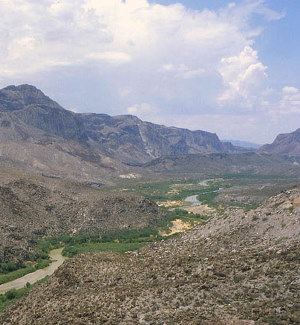
View looking upstream of the Rio Grande between Lajitas and Redford. The Chisos bands lived mainly on the Chihuahuan side of the river in the rugged and arid mountains and basins of the Chihuahuan desert. Photo by Andy Cloud.  |
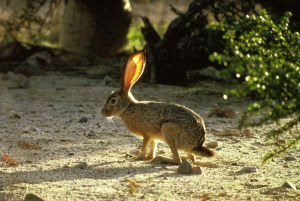
Black-tailed jackrabbit. Rabbit was one of the most important animals to the native peoples of the Trans-Pecos, undoubtedly including the Chisos peoples. Virtually every archeological site in the Trans-Pecos with preserved animal bones contains the remains of rabbit, and at many sites rabbit dominates the faunal assemblage. Photo courtesy U.S. Fish and Wildlife Service.  |
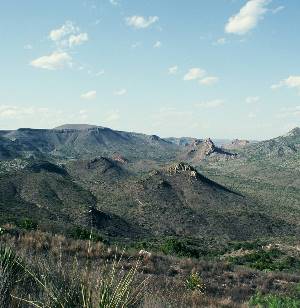
The Sierra Encantadas in northwestern Coahuila were probably part of the traditional homeland of the Chisos. The region is characteristically rough and dry, but springs occur in mountain canyons where animals and people take refuge. Photo by Solveig Turpin.  |
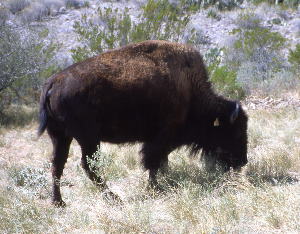
Juvenile bison grazing at Nine Point Mesa in Brewster County. The Chisos were known to travel north across the Rio Grande to hunt bison. Photo by Andy Cloud.  |

Artist’s depiction of a Manso man. The Mansos were known for their distinctive red-plastered hair and were first encountered in the late 16th century when the first Spanish explorers visited the El Paso area. The Mansos were so named because their first words to the Oñate expedition were "manxo, manxo, micos, micos," which meant "peaceful ones" and "friends." Photo of display at the El Paso Museum of Archeology.  |
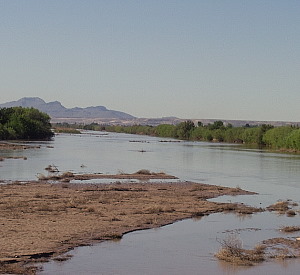
The Rio Grande above El Paso. Before the construction of the Elephant Butte dam near Truth or Consequences, New Mexico, the Rio Grande was unpredictable, prone to flooding, drought and channel-switching. The Mansos caught fish, ducks, cranes, and geese in the lagoons (abandoned river channels) on the Rio Grande. Photograph by Susan Dial.  |
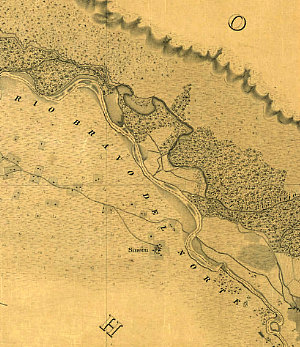
Detail of boundary map between the United States and Mexico, as surveyed by William H. Emory, U.S. Commissioner in 1855. The map shows the twisting and abandoned channels of the river, which centuries earlier had been the heart of the Manso homeland. Map courtesy of National Archives.  |
\

Cranes, ducks, and fish were harvested by the Manso from the lagoons of the Rio Grande. Images courtesy USFWS. |

"The Plaza and Church of El Paso," painted by artist A. de Vauducourt during the 1850s, depicts the mission of Nuestra Señora de Guadalupe de los Mansos. Founded for the Mansos in 1659, the mission was the first to be established in the El Paso area. Today the carefully restored church stands in downtown Ciudad Juárez.  |
|